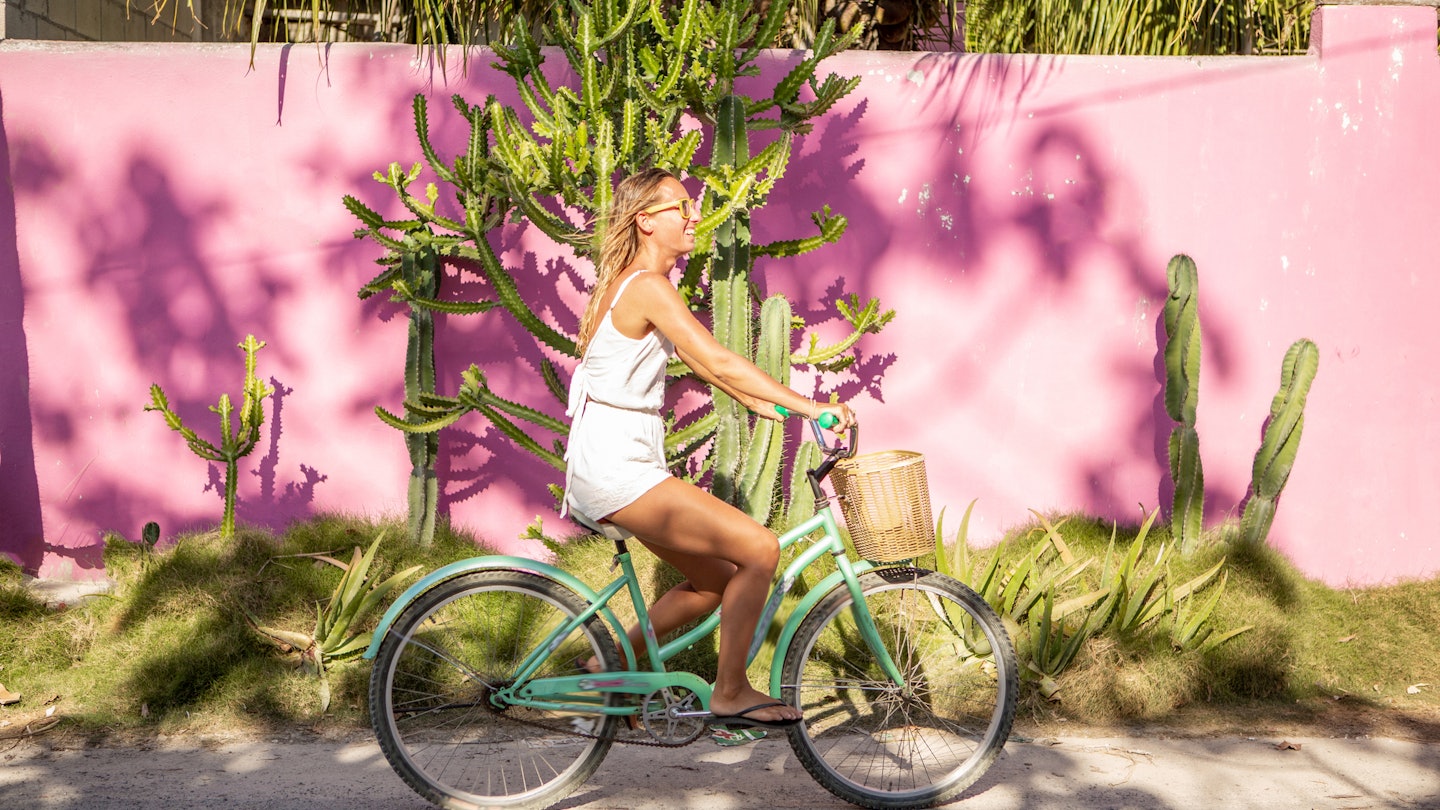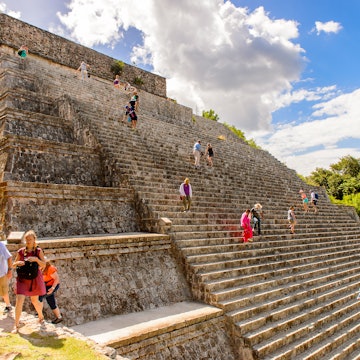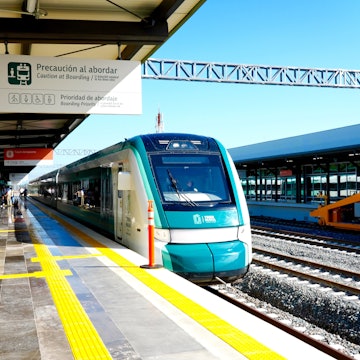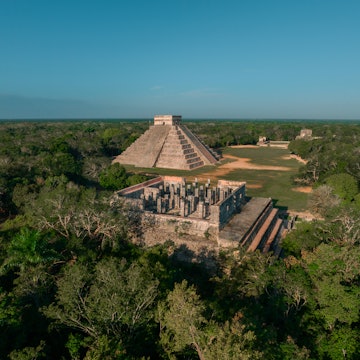

Find your way around Tulum, both the beach and the town, with this guide to public transportation and bike hire © swissmediavision / Getty Images
Tulum is a city of two halves: pueblo (town) and playa (beach), connected by a dusty paved road called Avenida Cobá. It’s not hard to get around either area – biking is popular and public transportation is robust – but the two areas are different.
Tulum Pueblo is a small gritty town that’s bustling with activity, making it most easily navigated by foot or bicycle. The beach, meanwhile, is long and languid, stretching 6 miles (10km) alongside a single leafy road; short walks are do-able but you’ll really need a set of wheels, of any sort, to get from place to place. Tulum ruins are located just to the north and can be accessed from either the beach or the town.
Find your way in Tulum with this guide to getting around.
Riding a bike is one of the best ways to see more of Tulum
Biking is perhaps the most popular way for travelers to get around Tulum. In town, there’s a designated bike lane that runs the length of the main drag. In the neighborhoods, the streets are narrow and there are no bike paths, but drivers are used to sharing the road.
Biking between town and the beach is a breeze too – just follow the paved path along Avenida Cobá. On the beach road itself, you’ll be grateful to be on two wheels as you pedal past stop-and-go traffic, especially on weekends.
Many hotels loan guests bikes for free and rental shops are plentiful, charging around M$150 per day, even less if you rent by the week. Ola Bike Tulum has a good selection of bikes, including cruisers with a basket and lock.
You can easily get around Tulum Pueblo on foot
Tulum Pueblo is a compact place, making it easy to explore on foot. Most of the action happens along (and near) a 10-block stretch of the main drag, Avenida Tulum. Here, the sidewalks are wide and well-maintained, and lined with knickknack shops, restaurants and tour operators. Strolling deeper into the neighborhoods, the sidewalks become narrow and uneven, but there’s also far less traffic; this is where you’ll find bars and small hotels, tiny cement parks and locals just living their lives.
While it’s possible to walk the 1.8 miles (3km) from Tulum Pueblo to Tulum Playa, it’s a long and often sweltering experience. There’s a paved path along Avenida Cobá leading to the beach road, but it’s also used heavily by cyclists and has little shade… not optimal for walkers. Halfway there, you may wonder why you did this to yourself.
The beach road itself isn’t too conducive to walking either. There are virtually no sidewalks, so pedestrians end up walking along the edges of the road with cars and cyclists whooshing by. Walking on the beach (if you can access it) is a much safer and more beautiful option.

Colectivos are cheap and frequent, but can be very busy
Colectivos (shared vans) are white retrofitted minivans with route names stenciled below the windshield. Favored by locals, they’re often packed but they’re cheap (M$15) and abundant, zipping around town from morning til night.
For travelers, popular colectivo routes include "Cabañas" for the southern beaches and "Ruínas" for the northern beaches. To reach Tulum ruins, take the Ruínas route to access the pleasant beachfront footpath or catch a Playa del Carmen-bound colectivo (M$20) from Tulum Pueblo and ask to be dropped off at the ruins. The stop is along the highway, about two blocks from the visitors' complex.
In town, the easiest place to catch a colectivo is on Avenida Tulum. Simply stand by the side of the road and as one approaches, hail it like a cab. If there’s space, the driver will stop; if not, another will pass in 10 or 15 minutes. Once you’ve boarded, tell the driver where you’d like to get off or just yell out "bajan!" (BA-hahn, meaning "getting off") and it’ll stop. Be sure to have change or small bills for the fare.
Taxis are readily available
Taxis are a reliable way to navigate Tulum, and also provide a nice break from having to navigate the traffic on your own. They ply the roads 24/7 and, despite having meters, charge fixed fares to common destinations: M$60 around Tulum Pueblo, M$100 to the ruins, and M$150 to M$250 between town and the beach, depending on the distance. Before stepping into the cab, confirm the fare – taxi drivers in Mexico are notorious for inflating prices for unsuspecting passengers.
Cabs are easy to hail in Tulum Pueblo. There’s also a taxi stand at the bus terminal and another on the central plaza; on the beach road, empty taxis congregate around Punta Piedra, Playa las Palmas and at the northern end of the beach road, where the footpath to the ruins begins. If you’re leaving from your hotel, the receptionist is likely to have a list of reliable drivers they’ll call. There are no rideshares – such as Uber or Lyft – in Tulum.
You might regret hiring a car
Driving around Tulum is a hassle. There’s a ton of traffic, especially during the high season, and parking is scarce. If you must, there are several car rental agencies in town ranging from big international chains to mom-and-pop operations; most have store fronts on Avenida Tulum and Avenida Cobá. You can also rent a car at the airport when you arrive.
Tip for parking at the beach: Consider going to a beach club – most offer free parking to their guests. Otherwise try your luck at finding a spot along the road or in a handful of public lots.

It takes around 45 minutes by taxi to get to Cobá on a day trip
Just 30 miles (50km) from Tulum Pueblo, Cobá ruins are worthy of a day trip away from the beach. Located on the edge of the same-named village, Cobá can be reached from Tulum via a well-maintained road, passing cenotes and Maya communities along the way. Colectivos (M$70, hourly 8am–6pm, 1.5 hours), first- and second-class buses (M$52–95, 8 departures, 1 hour) and taxis (M$500–600, 45 min) make the trip. Driving a rental car is a plus if you want to explore the town’s lesser-visited cenotes and the nearby nature reserve of Punta Laguna too.
Cobá ruins themselves are vast and tucked beneath a dense canopy of trees. You can explore them on foot, by bike (M$50) or pedicab (M$120-150).
There isn't a lot of accessible transportation in Tulum
Generally, Tulum is a tough place to navigate for travelers with disabilities. Sidewalks can be narrow and uneven, especially outside the main tourist corridor, and curb ramps are rare. Similarly, colectivos and buses aren’t retrofitted for people with disabilities. Taxis are likely to be your best option. That said, Mexicans generally have accommodating attitudes and special arrangements are gladly improvised. Download Lonely Planet's free Accessible Travel guide.
















